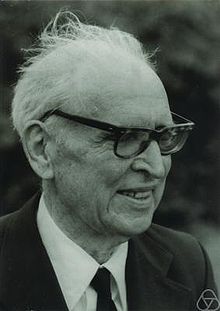Marcel Brelot

Marcel Émile Brelot (born December 29, 1903 in Châteauneuf-sur-Loire , † August 3, 1987 in Paris ) was a French mathematician who dealt with analysis, especially with potential theory .
Live and act
Brelot studied from 1924 at the École normal supérieure (together with many of the later Bourbakists , but he was often ill). After his Agrégation in 1927 he studied with a Rockefeller scholarship in Rome in 1929/1930 with Vito Volterra and then in 1930/31 in Berlin with Erhard Schmidt . In 1931 he received his doctorate. Then he was at the CNRS , which was then newly created under the name Caisse des Sciences, and a year at the Institut Français in Berlin. From 1933 to 1938 he was Chargé des Cours and then Maître de conférences in Algiers . It was there that he met his wife, whom he married in 1933. From 1938 to 1942 he was a professor in Bordeaux and then for two years in Grenoble , where he founded the Annales de l´Institut Fourier with Louis Néel . From 1953 he was in Paris, first as Maître de conférences (as was still the case with such a move to the capital), then as professor. From 1956 he had a seminar on potential theory in Paris, which soon became very influential and which he later led with Jacques Deny and Gustave Choquet . In 1968 he was visiting professor in Buenos Aires , in 1962 in Japan and in 1959 and 1966 at the Tata Institute in Bombay. He was also visiting professor at 10 universities in the USA and Canada.
Brelot dealt mainly with potential theory and developed under the influence of Bourbaki in the post-war period until 1957/8 an axiomatization of the theory of harmonic functions (Brelot's harmonic spaces), later further developed by Heinz Bauer and others. In 1939 he developed the PWB method ( Perron - Wiener -Brelot) to solve the Dirichlet problem and in 1938 a convergence theorem for subharmonic functions down to quantities of internal capacitance zero. The terms internal and external capacity (Capacité Interieure, Capacité Exterieure) and polar sets (Ensemble Polaire, as a substitute for sets of the internal capacity zero) in potential theory come from him.
In 1974 he became a corresponding member of the Académie des sciences , from which he also received four prizes (Francoeur 1939, Saintour 1945, Carrière 1952, Servant 1968). He was a corresponding member of the Bavarian Academy of Sciences . He was a Knight of the Legion of Honor. In 1960 he was President of the French Mathematical Society (Societé Mathématique de France) and he was secretary of the National Committee of French Mathematicians for 20 years.
Brelot had two sons. His son Alain Brelot was a solid-state physicist and died in an airplane accident in 1974.
Fonts
- Axiomatiques des fonctions harmoniques , 1965 (course in Montreal)
- On topologies and boundaries in potential theory , Lecture Notes in Mathematics, 1970
- Eléments de la théorie classique du potentiel , 1959
- La théorie modern du potentiel (de Gauss 1840 à 1952) , Annales Inst. Fourier 1952
Web links
- Choquet "La Vie et l´Oeuvre de Marcel Brelot", Cahiers du seminaire d´histoire des mathematiques 1990
- Author profile in the database zbMATH
- Literature by and about Marcel Brelot in the SUDOC catalog (Association of French University Libraries)
- Information on Marcel Brelot in the database of the Bibliothèque nationale de France .
References
- ↑ Developed independently by Antonie Frans Monna and Arne Beurling
| personal data | |
|---|---|
| SURNAME | Brelot, Marcel |
| ALTERNATIVE NAMES | Brelot, Marcel Émile (full name) |
| BRIEF DESCRIPTION | French mathematician |
| DATE OF BIRTH | December 29, 1903 |
| PLACE OF BIRTH | Châteauneuf-sur-Loire |
| DATE OF DEATH | 3rd August 1987 |
| Place of death | Paris |